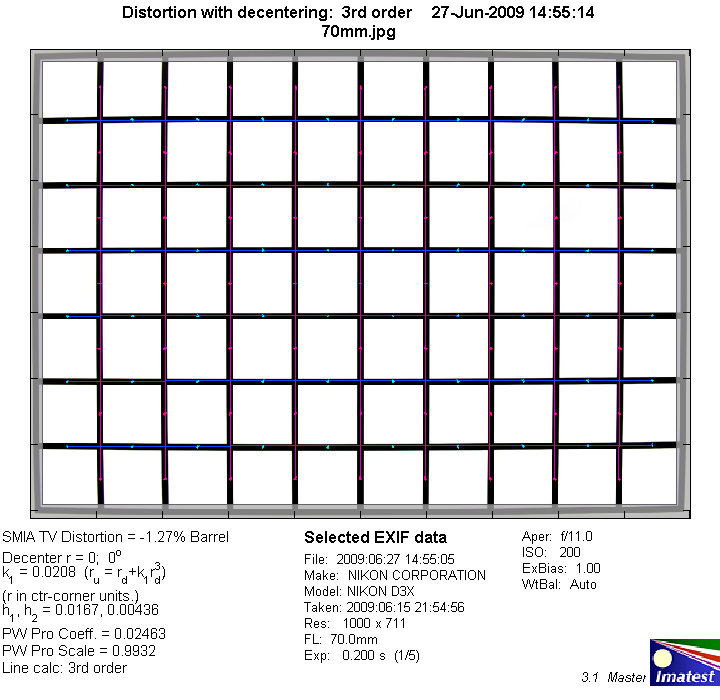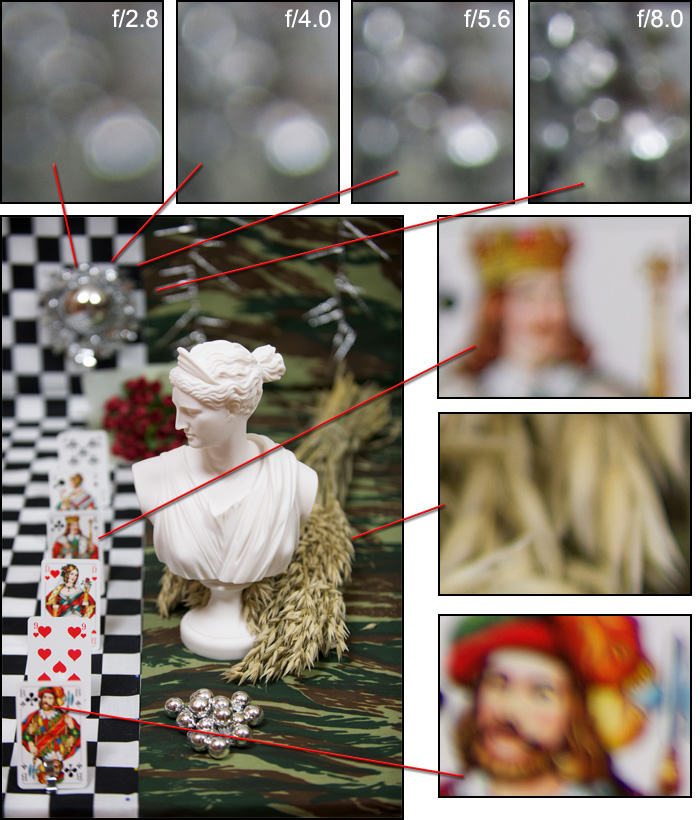|
Page 2 of 3

Distortion
The lens shows distortion characteristics that are typical for this lens class. At the short end there is barrel distortion of almost 1.3%, which flips over to around 1% pincushion distortion at 135 mm and just above 1.7% at 200 mm. Especially at the long end, that's fairly large amount, but the good news is that it is uniform distortion that is not too complicated to correct by software in post processing.
|
Move the mouse cursor over the focal length text marks below to observe the respective distortion
|
| 70mm |
135mm |
200mm |
|

|
The chart above has a real-world size of about 120x80cm.
Vignetting
With a fast zoom lens some vignetting has to be expected on a FX camera. At 70 mm light falloff is visible wide open with around 1 stop darkening towards the image corners, but from f/4 onwards vignetting is well controlled.
Things are a little worse at 135mm and 200mm. Wide open, the amount of vignetting is easily visible (also see the samples on page 3 of the review). At f/4 light falloff is down to just below 0.9 stops at 135 mm and 0.8 stops at 200 mm, however this is still an amount if vignetting that depending on the subject can be disturbing. Further stopping down helps to reduce vignetting considerably. From f/5.6 onwards vignetting may still be visible in critical scenes, however for most subjects it's probably no longer field relevant.
With a tele converter attached vignetting is not really field relevant, unless the lens is used wide open. However, as we will see below, this is probably not what you'd want to do anyway.
We're performing our vignetting analysis based on
(uncorrected) JPEGs straight from the camera. The JPG engine of the Nikon D3x features a rather flat
gradation curve, thus has a moderate contrast characteristic, resulting in comparatively low vignetting figures - the
corresponding Canon figures are roughly 40% higher due to the more
aggressive default contrast setting.

MTF (resolution)
At 70 mm and 135 mm the center resolution is excellent wide open already and remains on this very high level until diffraction kicks in at f/11. At 200 mm the center resolution starts a little lower wide open, but sharpness is still very good here and excellent stopped down.
At all focal lengths the borders show very good sharpness at all tested apertures, the same applies to corner sharpness at 70 mm and 135 mm. At 200 mm though the lens shows only good resolution, unless stopped way down to f/11.
We also measured resolution with tele converters attached. The measurements were done with the lens set to 200 mm.
With the TC-14E II the center resolution is only good wide open, but already very good at f/5.6 and excellent beyond. The borders and corners are very soft wide open and at f/5.6, the lens needs to be stopped down to f/8 to reach good sharpness here.
The TC-17E II reduces sharpness a little more. Center resolution is good wide open and at f/5.6, very good at f/8 and beyond, but no longer reaches excellent levels. Border and corners are very soft wide open and at f/5.6. Stopped down to f/8 and beyond the resolution increases to fair levels, at f/11 the border just reaches good resolution.
With the TC-20E II attached resolution drops further, center sharpness is just fair wide open, good at f/8 and very good by f/11. Borders and corners show poor resolution wide open and at f/8 and just fair results at f/11 and f/16.
We're a little worried about the amount of sample variation we saw during the creation of this review. A total of 4 lenses were run through the complete test cycle, two of which showed resolution values significantly below what you see in these charts. Two additional lenses were so soft wide open that we stopped to review them after just a few test shots.
In all cases softness wide open seemed to be a result of misalignment of one of the elements, maybe the VR unit (but this is pure speculation on our side).
Please note that the MTF results are not directly comparable across the different systems!
Below is a simplified summary of the formal findings. The chart shows line widths
per picture height (LW/PH) which can be taken as a measure for sharpness.
If you want to know more about the MTF50 figures you may check out the corresponding
Imatest Explanations

Chromatic Aberrations (CAs)
Chromatic aberrations (color shadows at harsh contrast transitions) are a well controlled at 135 mm and 200 mm but slightly higher at 70 mm with an average amount of 1.44 pixels wide open.
With the lens at its 200 mm setting, tele converters increase the amount of CAs significantly. However, CAs can easily be corrected in software or by the camera itself (most modern Nikon DSLRs remove CAs themselves if you shoot JPGs).

Bokeh
Being a fast tele lens one of the lens' welcome abilities is to seperate the main subject from the background, not only in portraiture. In this case the rendering of out of focus areas is an important aspect.
The 70-200 VR generally delivers very smooth bokeh at all focal lengths with just a minor amount of nervousness (see the crop of the king below).
Thanks to 9 rounded aperture blades, background highlights remain circular throughout the whole aperture and focal range. They show smooth filling with only slight outlining.
|
Move the mouse cursor over the focal length text marks below to observe the respective bokeh
|
| 70mm |
135mm |
200mm |
|

|
Bokeh Fringing / Longitudinal Chromatic Aberrations (LoCA)
LoCAs (non-coinciding focal planes of the various colors) are a common issue with relatively fast glass. As you can
notice below the halos have different colors - magenta (red + blue) in front the focus point
and green beyond. Truly "apochromatic" lenses don't show LoCAs but these lenses are very rare. Unlike lateral CAs, LoCAs cannot easily be fixed in post processing.
At it longest focal length of 200 mm (which we used for the shots below) the lens shows a moderate amount of LoCAs wide open, which is considerably reduced by f/4 already and no longer field relevant at f/5.6 and beyond.
|